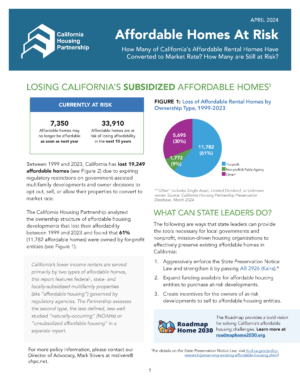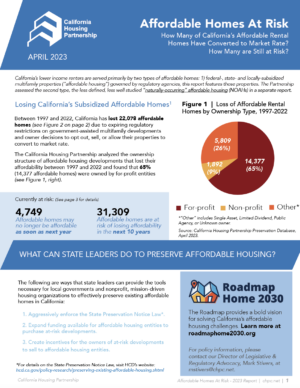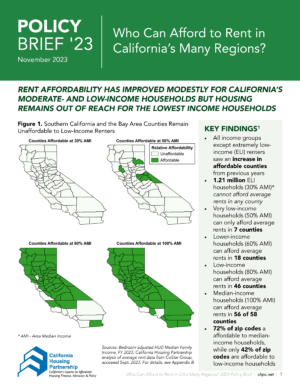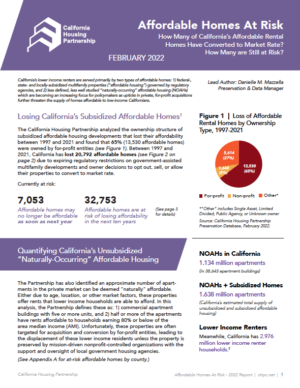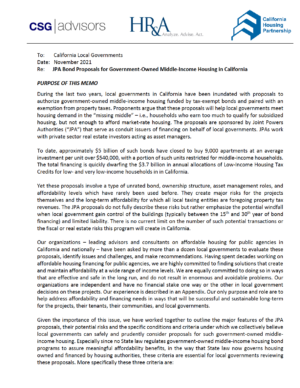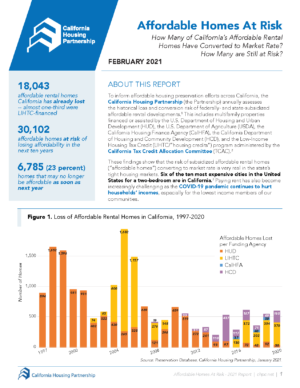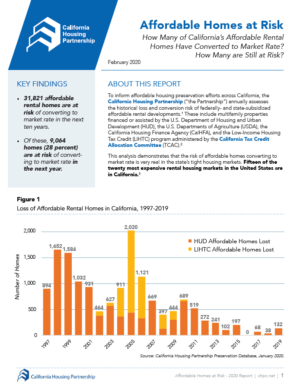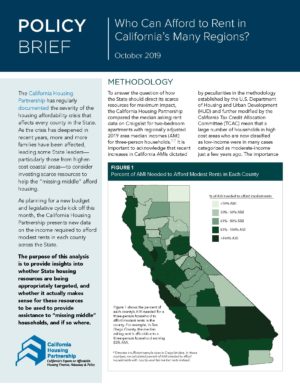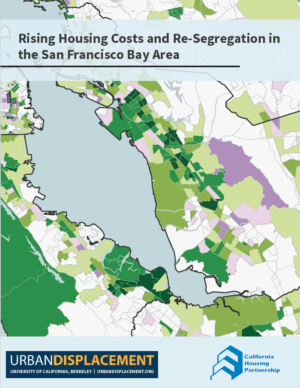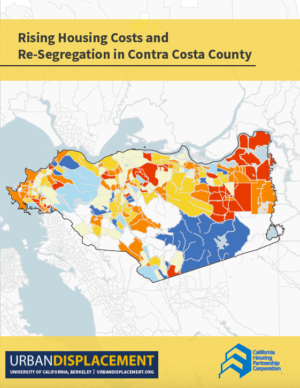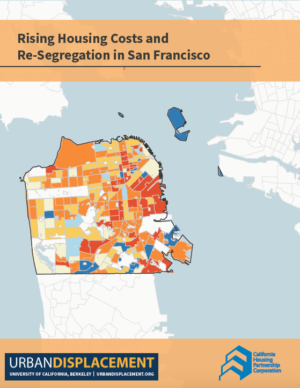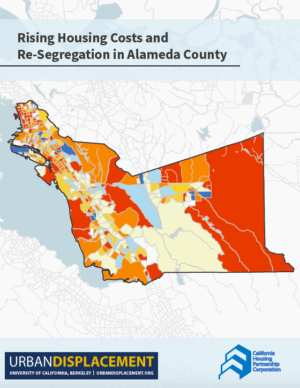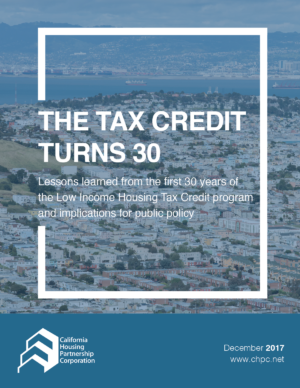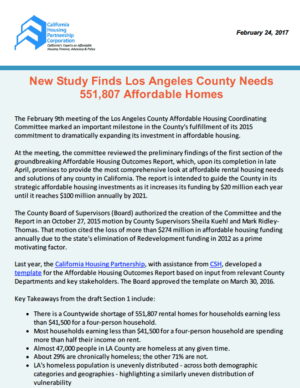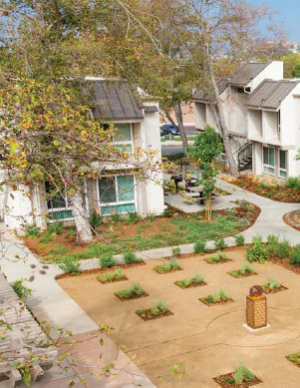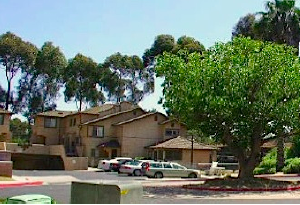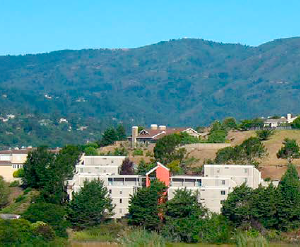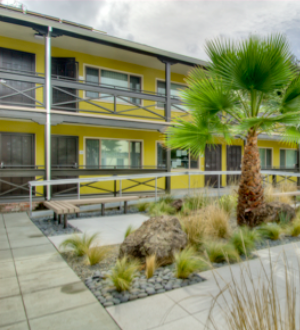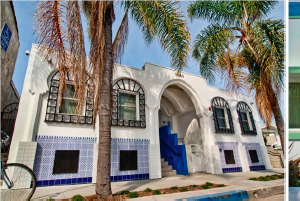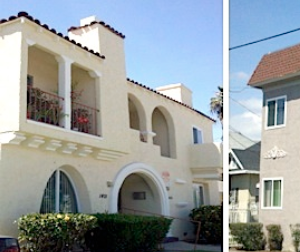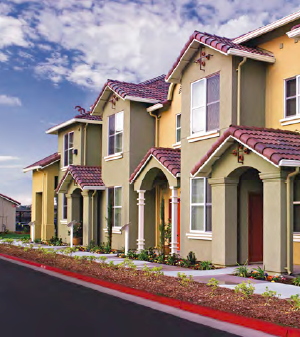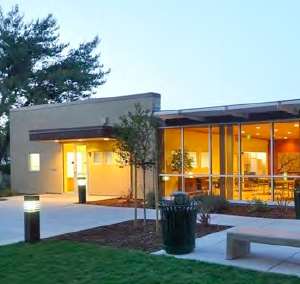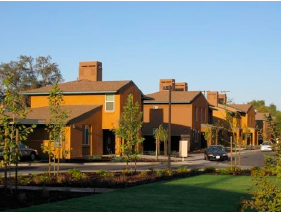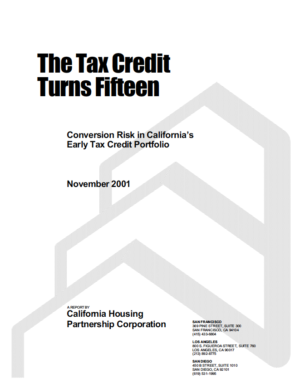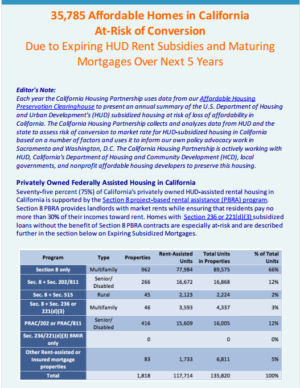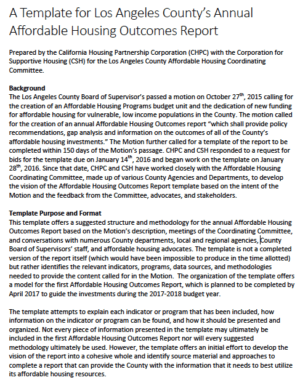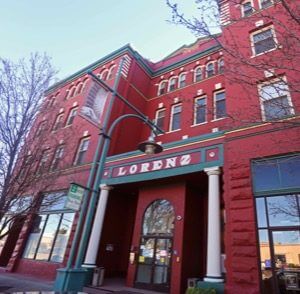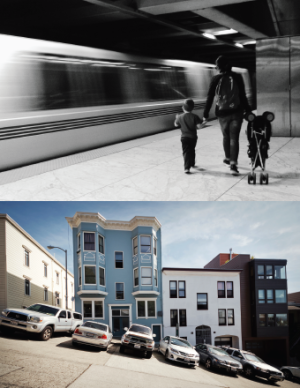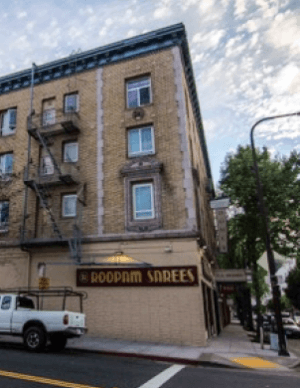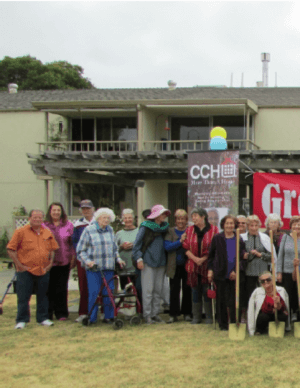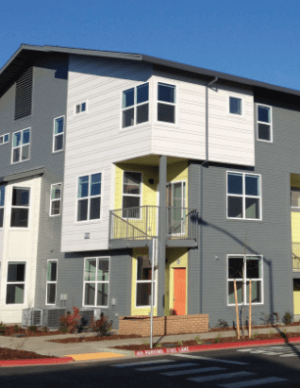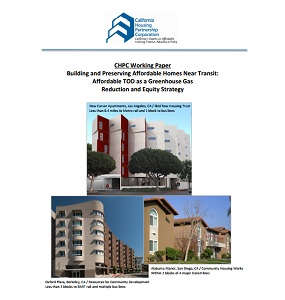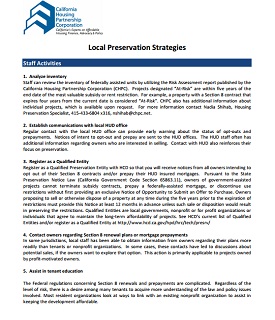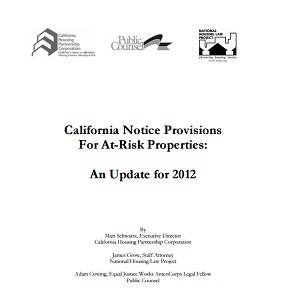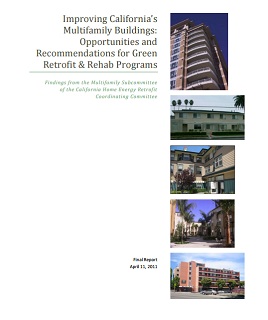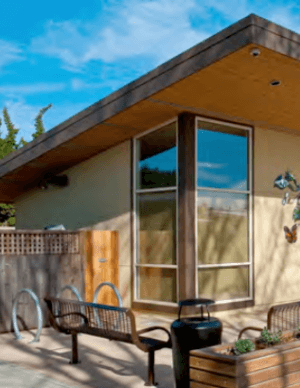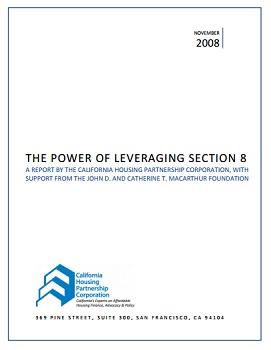Unsubsidized Affordable Homes At-Risk | 2024 Report
Using a proprietary methodology, the California Housing Partnership identified unsubsidized naturally-occurring affordable housing (NOAH) properties that due to their age, location and other market factors, offer rents affordable to low-income households. Notable findings in this 2024 report include: Already Lost 163,000+ homes are no longer affordable, largely concentrated in Read More
Affordable Homes At-Risk | 2024 Report
California’s affordable housing crisis will only worsen if nothing more is done to protect the thousands of subsidized affordable rental homes at risk of market rate conversion. According to the Affordable Homes At Risk | 2024 Report released April 5 by the California Housing Partnership: 19,249 subsidized affordable rental homes have Read More
2023 Subsidized Affordable Housing At Risk Report
California’s affordable housing crisis will only worsen if nothing more is done to protect the thousands of subsidized affordable rental homes at risk of market rate conversion. According to the Affordable Homes At Risk | 2023 Report released April 20 by the California Housing Partnership: 22,078 subsidized affordable rental homes have already been Read More
California Naturally-Occurring Affordable Homes At Risk Report 2023
Using a new, proprietary methodology, the California Housing Partnership is now able to identify unsubsidized naturally-occurring affordable housing (NOAH) properties that due to their age, location and other market factors, offer rents affordable to low-income households. This is the first statewide assessment of At-Risk NOAH that has been done to Read More
Policy Brief 2023: Who Can Afford to Rent in California’s Many Regions?
This 2023 policy brief investigates the income required to afford rent across California and the cost burden experienced by households in different income groups. The analysis provides insights indicating the need for state and local leaders to continue to prioritize scarce affordable housing resources for Californians at the lowest income Read More
Policy Brief 2022: Who Can Afford to Rent in California’s Many Regions?
This 2022 policy brief investigates the income required to afford rent across California and to better understand the cost burden experienced by households in different income groups. The analysis provides insights into whether state resources should be prioritized to provide assistance to “missing middle” households, and if so, where. View Read More
Affordable Homes at Risk | 2022 Report
California has already lost nearly 20,800 subsidized affordable rental homes, and today, another 7,053 subsidized affordable rental homes housing low-income seniors, families and individuals, are at risk of market rate conversion as soon as next year, according to this year’s Affordable Homes At Risk | 2022 Report by the California Housing Partnership. An estimate Read More
Policy Brief 2021: Who Can Afford to Rent in California’s Many Regions?
This 2021 policy brief investigates the income required to afford rent across California and to better understand the cost burden experienced by households in different income groups. The analysis provides insights into whether state resources should be prioritized to provide assistance to “missing middle” households, and if so, where. View Read More
Memo on JPA Bond Proposals for Government-Owned Middle-Income Housing in California
This memo from the California Housing Partnership, CSG Advisors and HR&A Advisors, Inc. highlights the urgent need for local governments to carefully weigh the potential pitfalls and opportunity costs associated with using property tax exemptions to finance the conversion of luxury apartments into government-owned middle-income housing in California. View the announcement
Affordable Homes At Risk | 2021 Report
California has already lost 18,043 subsidized affordable rental homes and today, another 6,785 subsidized affordable rental homes are at risk of market rate conversion as soon as next year. These homes house thousands of low-income seniors, families and individuals and can be found in 35 of California’s 58 counties, according to this year’s Affordable Homes Read More
Affordable Homes at Risk | 2020 Report
To inform affordable housing preservation efforts across the state, the California Housing Partnership annually assesses the historical loss and conversion risk of federally- and state-subsidized affordable rental properties. Our 2020 report, Affordable Homes at Risk, finds that California has already lost 15,004 affordable rental homes and that another 31,821 affordable rental homes Read More
Fact Sheet: AB 2058 | Affordable Housing Preservation Tax Credit
This Bill creates an Affordable Housing Preservation Tax Credit (AHPTC) to incentivize the preservation of existing affordable apartment properties and mobile-home parks by experienced affordable housing organizations.
Abode Communities Opens Rolland Curtis Gardens after 10-Year-Battle
On November 7, 2019, Abode Communities celebrated the grand opening of Rolland Curtis Gardens, marking a tremendous victory for residents and affordable housing advocates, and providing a fitting capstone to a fifteen-year battle against displacement of its low-income residents.
Policy Brief 2019: Who Can Afford to Rent in California’s Many Regions?
This 2019 policy brief investigates the income required to afford rent across California and to better understand the cost burden experienced by households in different income groups. The analysis provides insights into whether state resources should be prioritized to provide assistance to “missing middle” households, and if so, where.
California’s Affordable Rental Homes At-Risk of Conversion | 2019 Report
To inform affordable housing preservation efforts across California, the California Housing Partnership annually assesses the historical loss and conversion risk of federally- and state-subsidized affordable rental properties. This 2019 analysis demonstrates that the risk of affordable homes converting to market rate is very real in California’s tight housing markets.
Rising Housing Costs and Re-Segregation in the San Francisco Bay Area
This report by the California Housing Partnership and the Urban Displacement Project at UC Berkeley finds that rising housing prices in the Bay Area region were correlated with shifts in where low-income people of color lived between 2000 and 2015, and resulted in new concentrations of poverty and racial segregation.
County Supplement: Rising Housing Costs and Re-Segregation in the San Francisco Bay Area
This supplement contains county-level charts and tables that correspond with data in the regional report by the California Housing Partnership and the Urban Displacement Project at UC Berkeley that documents rising housing costs in the Bay Area. The supplement provides local data for residents, advocates, and policymakers.
Rising Housing Costs and Re-segregation in Contra Costa County
This report by the California Housing Partnership and the Urban Displacement Project at UC Berkeley finds that rising housing costs in Contra Costa County were correlated with shifts in where low-income people of color lived between 2000 and 2015, and resulted in new concentrations of poverty and racial segregation in Read More
Rising Housing Costs and Re-Segregation in San Francisco
This report by the California Housing Partnership and the Urban Displacement Project at UC Berkeley finds that rising housing costs in San Francisco were correlated with shifts in where low-income people of color lived between 2000 and 2015, and resulted in new concentrations of poverty and racial segregation in the county.
Rising Housing Costs and Re-Segregation in Alameda County
This report by the California Housing Partnership and the Urban Displacement Project at UC Berkeley finds that rising housing costs in Alameda County were correlated with shifts in where low-income people of color lived between 2000 and 2015, and resulted in new concentrations of poverty and racial segregation in the county.
The Tax Credit Turns 30
This anniversary report takes a look back at the first 30 years of operation of the Low-Income Housing Tax Credit (LIHTC) program to find out what happened to the earliest generation of developments in California that received allocations of housing credits from 1987 to 1989. Some of these developments were lost to conversion to Read More
Fact Sheet: AB 1521 | Preserving California’s Existing Stock of Affordable Rental Homes
Fact Sheet on AB 1521, which strengthens the state’s existing Affordable Housing Preservation Law by requiring that rental housing with expiring federal and/or state subsidies and/or affordability protections be offered for sale first to qualified preservation purchasers at market value.
2017 Preservation Report | Statewide At-Risk Assessment
CHPC’s annual statewide risk assessment shows 31,988 affordable homes are at risk of conversion to market rate within the next five years.
Affordable Homes At-Risk by County
This resource outlines the properties and units at risk of conversion to market rate housing by county as of March 2017. The California Housing Partnership determines the level of risk based on a variety of factors, including who owns the property, how it was financed, etc.
Newsletter: New Study Finds Los Angeles County Needs 551,807 Affordable Homes
February 24, 2017 newsletter announcing the initial results of CHPC’s Affordable Housing Outcomes Report for the County of Los Angeles.
San Francisco Begins Second Phase of RAD Public Housing Initiative
Friday, October 14, 2016 marked a major milestone in San Francisco’s ambitious plan to revitalize its public housing properties through the U.S. Department of Housing and Urban Development’s Rental Assistance Demonstration (RAD) program. Financing closed on the last of the 14 properties in the second phase of SF RAD on Read More
Poway Villas: A Winning Formula for Preservation
Poway Villas is a 60-apartment, 100% Section 8 community in the City of Poway, California. The 40-year-old property was preserved by San Diego-based Community Housing Works (CHW). Poway Villas is an example of how to successfully layer Low Income Housing Tax Credits (LIHTC’s) with Department of Housing and Urban Development Read More
Juniper Gardens: Wakeland Housing Uses New CalHFA Program to Preserve 40 Affordable Homes in San Diego
San Diego-based Wakeland Housing & Development Corporation purchased Juniper Gardens, a 40-apartment Section 8 community in the City Heights neighborhood of San Diego, in March 2012 with the goal to refinance and recapitalize the property in order to ensure its long-term affordability. Wakeland Housing took advantage of the CalHFA new Read More
Sunny Meadows: MidPen Housing Preserves 200 Affordable Homes in Santa Cruz County
On August 16, MidPen Housing Corporation celebrated the renovation of Sunny Meadows, a 200-unit, two-story, garden-style affordable apartment complex in the city of Watsonville. With 22 buildings spanning 14 acres, Sunny Meadows is one of the largest apartment complexes in Santa Cruz County and an important fixture in the Watsonville Read More
Preservation through Stewardship: The Story of EAH Housing and Shelter Hill in Mill Valley, CA
In 1975, EAH Housing and Interfaith Housing Foundation (IHF) joined forces to build Shelter Hill, a 75‐unit family development made possible by the city of Mill Valley’s new inclusionary zoning ordinance. This case study highlights the critical stewardship role that one large nonprofit housing organization took on to help a smaller Read More
Erna P. Harris Court: Supportive Housing for Formerly Homeless in Berkeley “Goes Green”
In 1991, Berkeley-based Resources for Community Development (RCD) first began working on Erna P. Harris Court in Berkeley to transform the 1950’s-era motel into 35 units of affordable, supportive housing for homeless and disabled adults. By 2008, through advancements in green building, RCD was able to rehabilitate the property using Read More
Mercy’s Boulevard Court Apartments: Transformation from Roadside Motel to Supportive Housing for the Homeless
On October 6, Mercy Housing California and the Sacramento Housing and Redevelopment Agency (SHRA) celebrated the grand re-opening of the Boulevard Court Apartments in Sacramento. This partnership succeeded in transforming a once blighted motel into 75 units of permanently affordable housing for formerly homeless individuals with disabilities.
Turk & Eddy: Preserving HUD-Assisted Homes and Creating Jobs with the Help of Federal Stimulus and Redevelopment Funds
The Turk and Eddy apartment buildings are two separate mid-rise buildings built in 1923 and 1925 in San Francisco’s Tenderloin neighborhood, providing 82 affordable studio and one-bedroom apartments for extremely low-income seniors. In 2007, after the property faced the threat of converting to market-rate, the Tenderloin Neighborhood Development Corporation (TNDC) Read More
“Preserving” Market Rate Properties to Reduce Homelessness: The Courtyards in Long Beach
In 2008, Clifford Beers Housing purchased The Courtyards in Long Beach and saw a tremendous opportunity to rehabilitate and preserve the four 1920’s-era, single-story, courtyard-style apartment buildings. The Courtyards was among one of the first projects in the state to use California’s Mental Health Services Act capital funds to create Read More
Preservation of PHD Apartments In Los Angeles Demonstrates Impact of Federal Stimulus and State Preservation Notice Law
In August 2007, Little Tokyo Service Center (LTSC) partnered with the Korean Youth and Community Center (KYCC) to acquire the Professional Housing and Development (PHD) apartments in Los Angeles and preserve the affordability of the property.
Parc Grove Commons: Neighborhood Revitalization in Fresno Made Possible through $5.7 million in Federal Stimulus Funds
In April 2011, the Housing Authority of the City of Fresno (HACF) celebrated the grand opening of Parc Grove Commons, a 215-apartment mixed-income community made possible through $5.7 million in federal stimulus funds from the 2009 American Recovery and Reinvestment Act (ARRA). Through this energy-efficient neighborhood revitalization effort, HACF created Read More
Eden Housing Perseveres in Transforming Low-Income Community in Alameda County
In May 2008, Eden Housing set out to rehabilitate Ashland Village, the 142-apartment community in unincorporated Alameda County. Despite the Section 8 contract facing expiration in one year, Eden succeeded in preserving the affordability of the apartments and creating a healthier, more supportive environment for its residents.
St. Joseph’s Senior Apartments Groundbreaking: Historic Rehabilitation through Tax Credit Financing
The groundbreaking of St. Joseph’s Senior Apartments in Oakland in May 2010 marks the start of a large development by BRIDGE Housing to create affordable senior housing while also preserving a significant historic landmark. The development will include 84 affordable apartments for low and very low-income seniors and ground floor Read More
Yosemite Village: HOPE VI Development Revitalizes Distressed Housing in West Fresno
This month, the Housing Authority of the City of Fresno celebrates the grand opening of Yosemite Village, the newly revitalized property providing 69 affordable units for families in West Fresno.
The Tax Credit Turns Fifteen
CHPC investigates the benefits and impact of the Low-Income Housing Tax Credit (LIHTC) program as it approaches its fifteenth year, and the first tax credit-funded developments that began to be at risk of conversion.
35,785 Affordable Homes in California At Risk of Conversion | 2016 Preservation Report
Each year the California Housing Partnership uses data from our Affordable Housing Preservation Clearinghouse to present an annual summary of the U.S. Department of Housing and Urban Development’s (HUD) subsidized housing at risk of loss of affordability in California. The following summary is as of April 2016.
Affordable Housing Outcomes Report Template
The California Housing Partnership developed this template in 2016 for the County of Los Angeles. Although this template was designed specifically for the County of Los Angeles, it can be used by other jurisdictions as a starting point for deciding how to allocate funding for affordable housing in their communities.
Nonprofit Uses Financing Partnerships to Preserve At-Risk Property Despite Competition
Azusa Apartments is an 88-apartment affordable housing development located in Azusa, California, a Los-Angeles area suburb. The property was built in 1971, subsidized by a U.S. HUD Section 236 loan. After the loan reached the end of its 40-year term in 2012, Community HousingWorks stepped in to preserve the development.
Preserving a Historic Hotel with Innovative Financing and the Partial Transfer of a Section 8 Contract
In February 2015, Christian Church Homes (CCH) celebrated the grand re-opening of the Lorenz Senior Apartments in Redding, California after a major rehabilitation. A historic hotel that had been converted to senior housing, the Lorenz was in need of structural upgrades and repairs and improvements.
Preservation of Affordable Homes Near Transit Toolkit
This toolkit outlines how community-based organizations and advocates for equitable transit-oriented development can work together with local jurisdictions to assess the risk of losing existing affordable homes both a property and a neighborhood level, and to take concrete steps to reduce the negative impacts of transit oriented development on existing Read More
University Avenue Homes: A Critical Resource in Need of TLC
UA Homes is one of many aging SRO properties in California that provide an important affordable housing resource for low‐income people who would otherwise be homeless. However, at nearly 90 years of age and with complicated layers of restrictive financing, UA Homes badly needed a major physical and financial rehabilitation. Read More
Garfield Park Village Pioneers SPRAC for Unassisted Section 202 Properties
Located in Santa Cruz, California, and owned and managed by Christian Church Homes (CCH), Garfield Park Village is an affordable senior apartment complex developed in 1964 with a HUD Section 202 Supportive Housing for the Elderly Subsidized Mortgage. In Dec 2013, Garfield Park became one of the first Section 202 Read More
HUD Preservation Round Two: Ensuring the Long-term Financial, Physical, and Environmental Sustainability of a LIHPRA Property
Los Robles Apartments is a 76-unit, multifamily, affordable development located in the city of Vista in San Diego County. The property was built in 1974 using a (HUD) Section 236 subsidized mortgage. By 1996, the for-profit owner of Los Robles was considering converting the development to market-rate. Community Housing Works Read More
Preserving Affordable Housing Near Transit in Fremont | Summary and Recommendations
This memo summarizes the policy, data, and spatial analysis that Reconnecting America (RA) and the California Housing Partnership Corporation (CHPC) completed for the City of Fremont with the goal of helping the City of Fremont identify highest-priority affordable housing preservation areas near transit stations as well as the most effective Read More
Preserving Affordable Housing Near Transit in San Jose | Summary and Recommendations
This memo summarizes the policy, data and spatial analysis that Reconnecting America (RA) and the California Housing Partnership Corporation (CHPC) completed for the City of San Jose, with the aim of identifying the affordable housing reservation need near transit in San Jose. The memo also includes a set of recommendations Read More
Eden Housing Pioneers a New Model for Recapitalizing Aging HUD 202 Properties
In March 2013, after years of effort, Eden Housing closed the financing and began rehabilitating six properties originally built with Section 202 loans more than twenty years earlier. This case study highlights their innovative approach.
The Cambridge Apartments: Preserving Permanent Supportive Housing for the Long Term
On Thursday, July 18th, Community Housing Partnership (CHP), celebrated the grand reopening of the Cambridge Apartments with 60 efficiency units for formerly homeless adults in San Francisco’s Tenderloin neighborhood. Preserving housing for California’s most vulnerable low-income residents is challenging work involving complex efforts to navigate and integrate funding programs and Read More
Public Housing Transformation: Maple Park Apartments in Live Oak, CA
On May 29th, 2013, the Regional Housing Authority of Sutter and Nevada Counties (RHASNC) and its nonprofit development partner, the Community Housing Improvement Program (CHIP), as well as members of the local community, celebrated the completion of Phase I of the newly rebuilt Maple Park Apartments in the Sutter County Read More
Revitalizing the Evergreen Apartments
The City of Long Beach helps Abode Communities Preserve 81 Affordable Homes. US Bank became the LIHTC investor, while Union Bank was the bond purchaser and lender. Together, they extended affordability for an additional 40 years.
Building and Preserving Affordable Homes Near Transit
CHPC initiated this report in order to assess existing research on the role of preservation and development of affordable housing in transit--oriented corridors as a greenhouse gas (GHG) reduction strategy for California. As a result of our extensive review of existing literature, we have found three important trends : 1) Read More
Local Preservation Strategies
1. Analyze inventory Staff can review the inventory of federally assisted units by utilizing the Risk Assessment report published by the California Housing Partnership Corporation (CHPC). Projects designated “At—Risk” are within five years of the end date if the most valuable subsidy or rent restriction. For example, a property with Read More
California Notice Provisions for At-Risk Properties: An Update for 2012
As of November 2011, California has more than 438,000 apartments serving low income households earning less than 80% of area median income: 116,099 are subsidized and regulated by the US Department of Housing and Urban Development (HUD), 22,912 are subsidized by the US Department of Agriculture (USDA), 40,500 are public Read More
Improving California’s Multifamily Buildings: Opportunities and Recommendations for Green Retrofit and Rehab Programs
In California, the single-family home weatherization and whole-house performance sector is very active, with many programs already in place and new ones that began rolling out in the fall of 2010. While these programs have the potential to achieve impressive energy savings, their approaches do not neatly carry over into Read More
The Arbors: Green Preservation Rehab
The Arbors is a success story that shows how an experienced nonprofit housing developer working in partnership with a mission driven local nonprofit lender can overcome huge financing obstacles to transform older HUD-assisted housing into healthier green housing that will remain affordable for future generations of low income Californians.
The Power of Leveraging Section 8
The U.S. population is expected to exceed 349 million by 2025, an increase of 67 million people over the year 2000. This unprecedented growth in the U.S. will necessitate tremendous investment in new housing units to accommodate some 32 million households by 2025. As one researcher noted, this new housing Read More


